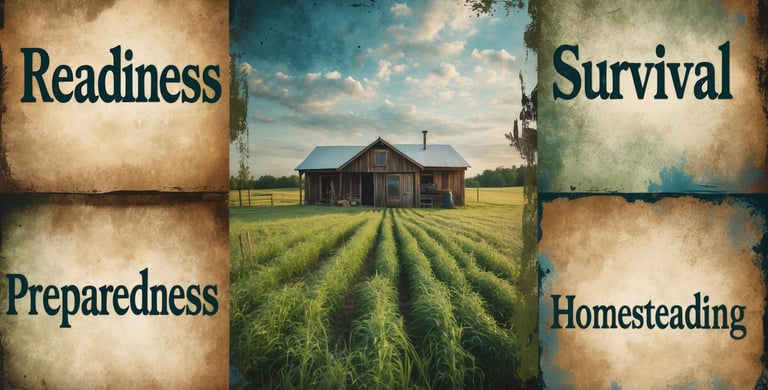Homesteading: Soil and Growing Systems
Creating a Food-Producing Homestead in Any Environment
4FORTITUDER - READINESS, SURVIVAL, PREPAREDNESS, HOMESTEADING
Homesteading: Soil and Growing Systems
Creating a Food-Producing Homestead in Any Environment
“He who plants a garden plants hope. He who tends the soil tends his soul.”
— 4FORTITUDE Agrarian Creed
If You Control Your Soil, You Control Your Survival
Collapse doesn’t care how much food you stored—it cares how fast you can produce more.
And that begins with soil. Not as dirt, but as living infrastructure—the foundation of sovereignty, nutrition, and long-term resilience. The difference between a prepper and a homesteader is this: one stores calories, the other grows them.
To understand soil is to understand the lifeblood of every enduring civilization. And to master it is to declare, “I do not ask for bread—I grow it.”
Core Knowledge Foundation: The Four Pillars of Food-Producing Systems
Soil Creation and Health – How life starts beneath your feet.
Growing Methods for Every Environment – Matching technique to terrain.
Crop Selection and Food Yield Strategy – What feeds you fastest, deepest, and longest.
Harvest, Rotation, and Regeneration – Building loops, not lines.
Misconception Warning: Soil is not a resource—it’s a living system. Without it, you aren’t growing—you’re gambling.
1. Soil Creation and Health
Goal: Build nutrient-rich, biologically active soil from scratch—or restore dead ground into fertile land.
Core Principles:
Organic Matter: Compost, leaves, manure, biochar
Life Above + Below: Worms, fungi, bacteria, root diversity
No-Till Approach: Preserve structure, water retention, and microbial ecosystems
Steps to Build Soil:
Choose site with 6+ hours of sunlight
Layer cardboard + compost + soil = instant raised bed (lasagna method)
Water deeply + mulch heavily = microbe haven
Rotate crops + add compost = long-term fertility
Tools:
Pitchfork, broadfork
Compost thermometer
Mulch (wood chips, straw, leaves)
Drill: Create 2x2 foot test plot. Use 3 soil-building methods. Track water retention, growth rate, and worm activity for 30 days.
2. Growing Methods for Every Environment
No Land? No Problem. Homesteading grows where discipline lives.
Top Methods Based on Constraints:
Urban/Small Space:
Container gardening (5-gallon buckets, grow bags)
Vertical gardens (trellis, wall-mounted planters)
Windowsill herbs (basil, thyme, mint)
Suburban/Backyard:
Raised beds (4x8 ft)
Square foot gardening
Companion planting for pest control
Acreage/Rural:
Row gardening with crop rotation
Food forest guilds (perennials, trees, nitrogen fixers)
Animals integrated with crop land (rotational grazing, chicken tractors)
Drill: Choose 1 growing method suited to your land. Build it. Grow one staple crop to harvest in 90 days (radish, lettuce, beans, potatoes, etc.).
3. Crop Selection and Food Yield Strategy
Goal: Prioritize crops that give you volume, density, and regeneration.
Three-Tier System:
Fast Growers (30–60 days):
Radish, arugula, green onion, lettuce
Re-seed bi-weekly for ongoing harvest
Calorie Staples (90–120+ days):
Potatoes, beans, squash, corn
High-volume, high-calorie output
Perennials and Regenerators:
Asparagus, rhubarb, berry bushes
Kale, collards, Jerusalem artichoke
Crop Families to Rotate:
Nightshades (tomato, pepper, eggplant)
Legumes (peas, beans—nitrogen fixers)
Brassicas (cabbage, broccoli)
Alliums (garlic, onion)
Drill: Build a three-season planting plan using fast-grow + staple + perennial categories. Assign planting, harvest, and composting dates.
4. Harvest, Rotation, and Regeneration
This is not farming. It’s husbandry of soil and system.
Harvest Techniques:
Early morning harvest = higher nutrient density
Stagger planting = ongoing supply
Learn proper pulling/cutting techniques to avoid plant shock
Regeneration Methods:
Composting:
Kitchen scraps + browns + oxygen = next year’s soil
Cover Crops:
Buckwheat, clover, rye = weed suppression + soil rebuilding
Green Manure:
Letting crops decay in soil to restore balance
Rotation Example (Yearly):
Legumes → Leafy Greens → Fruit-bearers → Root crops → Cover crop → Repeat
Drill: After one harvest, track what depleted and what flourished. Adjust next planting accordingly. Begin composting from the first pulled crop.
Advanced Insights: The Soul in the Soil
Soil teaches rhythm, not speed. Presence, not pressure. It humbles the impatient, rewards the faithful, and turns even ruin into resurrection.
The gardener does not rush. He partners. And in collapse, he becomes the quiet king—who feeds not with wealth, but with wisdom beneath his boots.
Historical Anchor:
The “Victory Gardens” of WWII fed nearly 40% of America’s produce needs from backyards and schoolyards. Not out of luxury—but from conviction: “We grow because we must.”
In a world where systems fail, the man with a trowel becomes more vital than the man with a badge.
Critical Perspectives: “Gardening Takes Too Long”
Adversarial Viewpoint:
“In a crisis, there’s no time for crops. Just store food and wait.”
Response:
Stockpiles run dry. Trucks stay stopped. And morale without growth dies. Gardening isn’t a luxury—it’s the long game that feeds generations. Every seed planted today is a fist raised against dependence tomorrow.
Wisdom and Warning Duality
When Followed: You become calmer, stronger, more fed—and less owned.
When Ignored: You starve slowly while sitting on soil that could’ve saved you.
Strategic Crossroad: Will you grow now—or grieve later?
Final Charge & Implementation
Brother, the land is waiting. The seed doesn’t ask for a future—it creates it. And your family, in the coming scarcity, won’t ask for your politics, your opinions, or your gear.
They’ll ask: “What can we eat?”
Start Now:
Build Your 4-Layer Growing System
“You aren’t preparing unless you’re planting.”
Soil zone (compost + mulch)
Grow zone (container/bed/field)
Seed zone (storage, sprouting, cycling)
Regeneration zone (cover crop or composting)
Conduct the Grow to Table Drill
“The seed is the first form of sovereignty.”
Grow one meal component from seed
Harvest it
Eat it with family
Share its story with your child
Strategic Reflection:
If you were handed a shovel and a seed right now… could you feed anyone in 90 days?
Existential Challenge:
Are you a man of the soil—or still just a man of the store?
Build what no inflation can destroy. Grow what no government can tax. Harvest what no supply chain can delay.
“The prepared man doesn’t just store food—he grows tomorrow from his backyard.”


